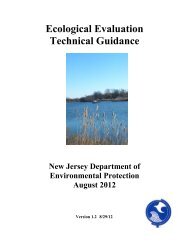Technical and Regulatory Guidance for In Situ Chemical ... - ITRC
Technical and Regulatory Guidance for In Situ Chemical ... - ITRC
Technical and Regulatory Guidance for In Situ Chemical ... - ITRC
You also want an ePaper? Increase the reach of your titles
YUMPU automatically turns print PDFs into web optimized ePapers that Google loves.
8. Service Station Site in Madison, WI<br />
Background<br />
The service station site located in Madison, Wisconsin, is an operating gasoline service station. The<br />
existing underground storage tank (UST) system consists of one 4,000-gallon gasoline tank, one<br />
4,000-gallon diesel tank, <strong>and</strong> two dispenser isl<strong>and</strong>s. <strong>In</strong> addition, one 550-gallon waste oil tank <strong>and</strong><br />
one 550-gallon fuel oil tank exists on the property. On August 14, 1995, one 8,000-gallon gasoline<br />
tank was removed from the site. The remaining four USTs are proposed to be removed prior to<br />
remedial activities. All of the USTs are registered with the Wisconsin Department of Commerce<br />
(DCOM).<br />
A petroleum release was detected on May 11, 1994, from a soil sample collected from beneath the<br />
east unleaded dispenser isl<strong>and</strong> <strong>and</strong> analyzed <strong>for</strong> Gasoline Range Organics (GRO). The test results<br />
indicated a GRO concentration of 4,200 mg/kg, which is above the soil cleanup st<strong>and</strong>ards <strong>for</strong> GRO<br />
of 100 mg/kg. The WDNR was immediately notified of the release.<br />
Site Hydrogeology<br />
Soil types encountered during the investigation consisted of silty clay native to fill material with<br />
s<strong>and</strong> <strong>and</strong> gravel <strong>and</strong> organic matter extending to depths ranging from 6 to 11 feet below ground<br />
surface (bgs). These fill soils are underlain by brown to grey brown to red-brown silty s<strong>and</strong> to<br />
s<strong>and</strong> <strong>and</strong> gravel. This s<strong>and</strong>y gravelly soil extends to depths ranging from 15 to 17 feet bgs.<br />
Beneath the dense s<strong>and</strong>y/gravelly soil is friable light brown to white to pink s<strong>and</strong>stone bedrock to<br />
the maximum explored depth of 26 feet bgs. Groundwater is present at 16 to 20 feet below<br />
ground surface.<br />
Depth to groundwater in the site monitoring wells ranges from 16 to 20 feet below ground<br />
-5<br />
surface with a hydraulic conductivity of 10 . As evidenced during water sample collection,<br />
recharge is moderate, which is typical of saturated silty s<strong>and</strong>. The groundwater flow direction is<br />
predominantly toward the north/northwest. The flow direction is consistent with local<br />
topography.<br />
Design/Implementation<br />
Following the completion of the subsurface investigation, a remedial alternatives comparison<br />
was prepared <strong>and</strong> submitted to the DCOM <strong>for</strong> review <strong>and</strong> approval. The selected <strong>and</strong> approved<br />
remedial alternative was a limited hot-spot contaminated soil excavation with the injection of<br />
Hydrogen Peroxide/Ferrous Sulfate (HP/FS) injection to remediate contaminated groundwater<br />
within shallow bedrock. A wordplay was prepared <strong>and</strong> submitted to the WDNR <strong>for</strong> approval.<br />
Approval <strong>for</strong> the remedial approach was granted by the WDNR in March, 1998.<br />
Approximately 2,100 tons of contaminated soil were excavated <strong>and</strong> transported to the Madison<br />
Prairie Bio-Site on July 6 <strong>and</strong> 7, 1998. The chemical oxidation vendor per<strong>for</strong>med a HP/FS<br />
injection pilot-test during the week of July 13, 1998. Based on the results of the pilot test,<br />
including contaminant destruction, the absence of vapor migration based on screening of vent<br />
wells <strong>and</strong> subsurface utilities <strong>and</strong> neighboring basements; as well as other factors, full-scale<br />
treatment was determined to be feasible utilizing this technology. <strong>In</strong> late July/early August, 1998,<br />
45 injector wells (15 foot to 17 foot radius), <strong>and</strong> 14 vent wells were installed at the site covering<br />
an area of 220 foot by 200 foot. Full-scale chemical oxidation treatment of the petroleumcontaminated<br />
groundwater, saturated soils (including capillary fringe), <strong>and</strong> bedrock was<br />
per<strong>for</strong>med from late August to September 11, 1998. Approximately 15,000-gallons of Fenton’s<br />
B16
















